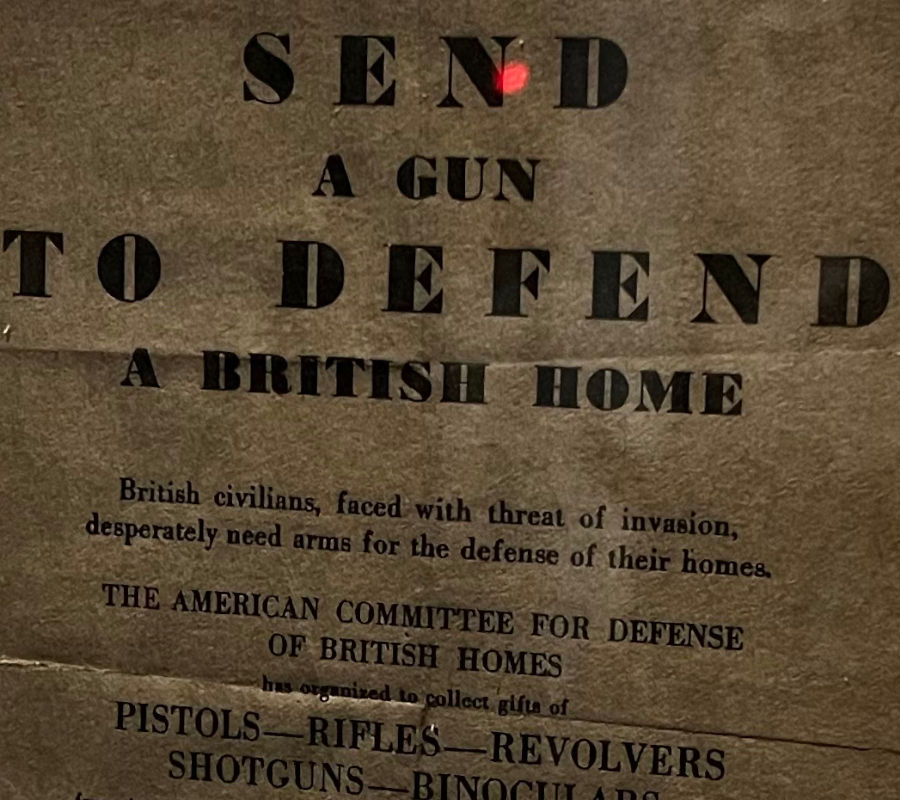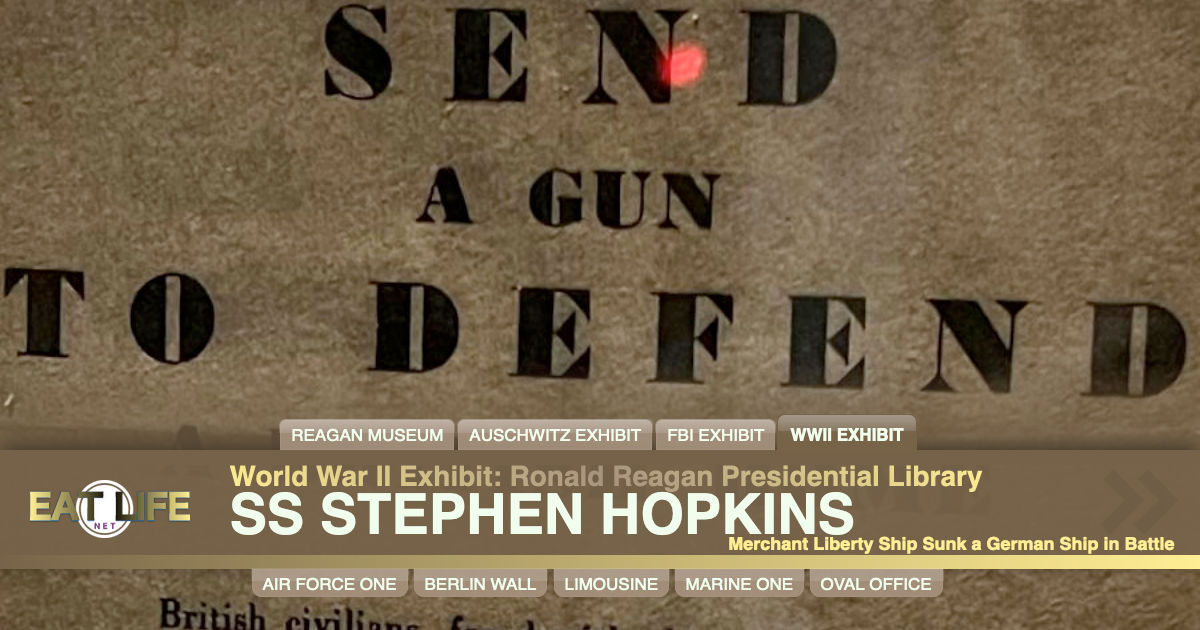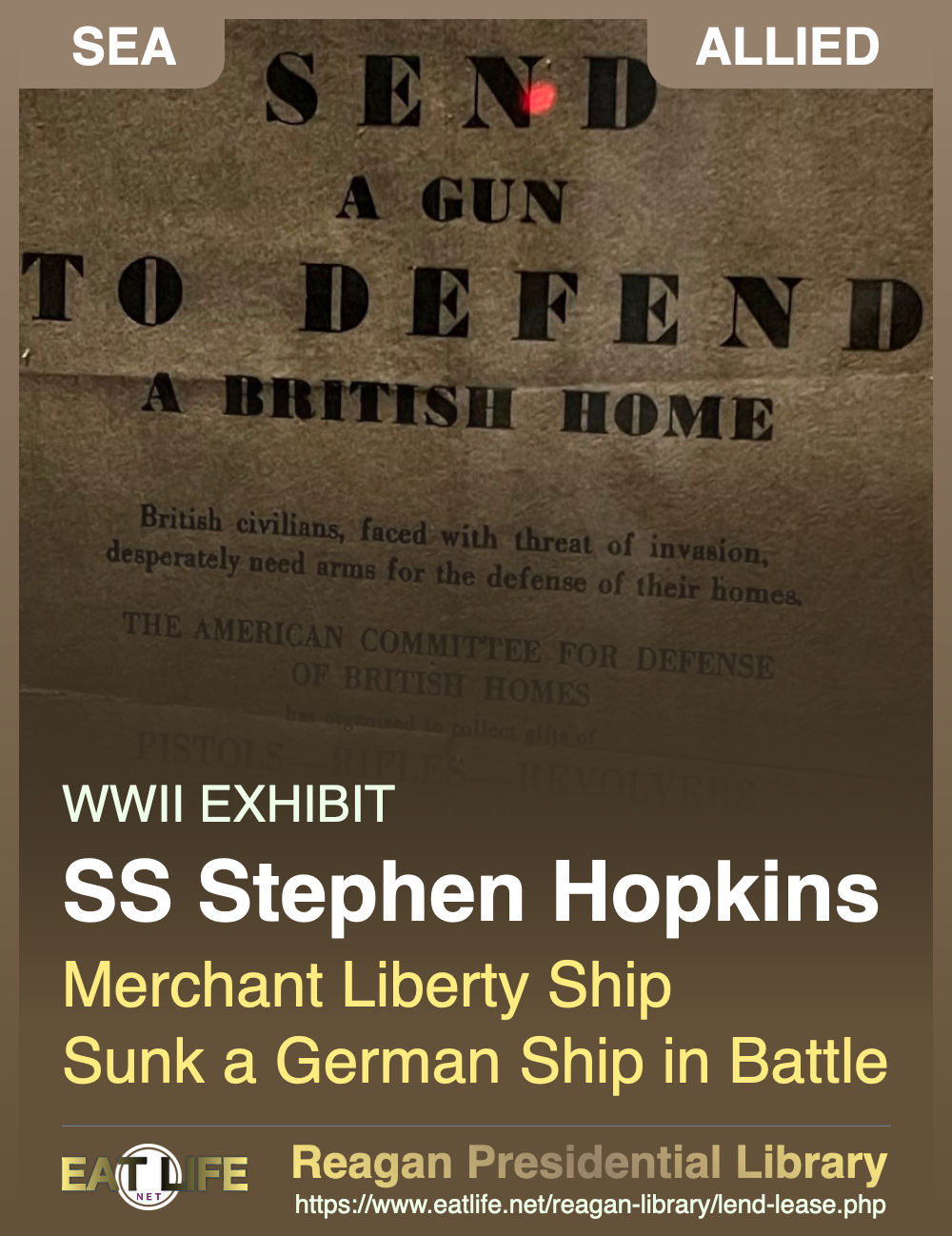The U.S. was mass producing these ships to supply Allied countries with food, oil, and materiel. There were a total of 2,710 ships built, and they were usually named after famous Americans, starting with the signatories of the Declaration of Independence.
In 1942 one of these merchant ships, the SS Stephen Hopkins, got into a fight with a German auxiliary cruiser, the Stier. The SS Stephen Hopkins sunk. 45 of her crew including the captain were killed in the action. 15 survivors drifted on a lifeboat for a month before reaching shore in Brazil. But the Stier was wrecked so bad they had to scuttle it. All but two of her crew survived the fight. This was the only time a US merchant ship sank a German surface combatant during the war.
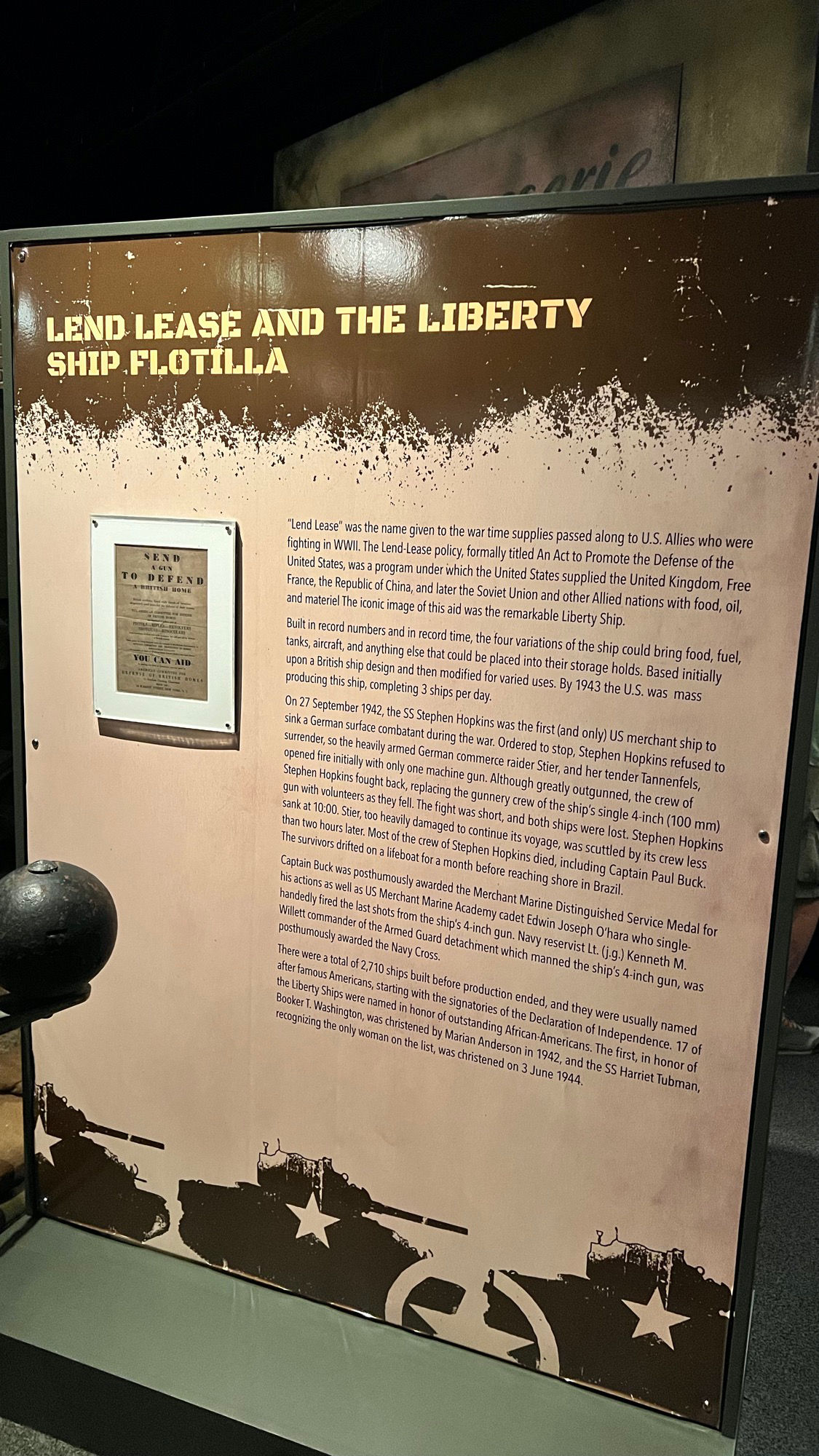
"Lend Lease" was the name given to the war time supplies passed along to U.S. Allies who were fighting in WWII. The Lend-Lease policy, formally titled An Act to Promote the Defense of the United States, was a program under which the United States supplied the United Kingdom, Free France, the Republic of China, and later the Soviet Union and other Allied nations with food, oil, and materiel. The iconic image of this aid was the remarkable Liberty Ship.
Built in record numbers and in record time, the four variations of the ship could bring food, fuel, tanks, aircraft, and anything else that could be placed into their storage holds. Based initially upon a British ship design and then modified for varied uses. By 1943 the U.S. was mass producing this ship, completing 3 ships per day.
On 27 September 1942, the SS Stephen Hopkins was the first (and only) US merchant ship to sink a German surface combatant during the war. Ordered to stop, Stephen Hopkins refused to surrender, so the heavily armed German commerce raider Stier, and her tender Tannenfels, opened fire initially with only one machine gun. Although greatly outgunned, the crew of Stephen Hopkins fought back, replacing the gunnery crew of the ship's single 4 inch (100 mm) gun with volunteers as they fell. The fight was short, and both ships were lost. Stephen Hopkins sank at 10:00. Stier, too heavily damaged to continue its voyage, was scuttled by its crew less than two hours later. Most of the crew of Stephen Hopkins died, including Captain Paul Buck. The survivors drifted on a lifeboat for a month before reaching shore in Brazil.
Captain Buck was posthumously awarded the Merchant Marine Distinguished Service Medal for his actions as well as US Merchant Marine Academy cadet Edwin Joseph O'Hara who single handedly fired the last shots from the ship's 4-inch gun. Navy reservist Lt. (j.g.) Kenneth M. Willet commander of the Armed Guard detachment which manned the ship's 4-inch gun, was posthumously awarded the Navy Cross.
There were a total of 2,710 ships built before production ended, and they were usually named after famous Americans, starting with the signatories of the Declaration of Independence. 17 of the liberty Ships were named in honor of outstanding African-Americans. The first, in honor of Booker T. Washington, was christened by Marian Anderson in 1942, and the SS Harriet Tubman, recognizing the only woman on the list, was christened on 3 June 1944.
Flotilla: - From Spanish Flota which means Fleet
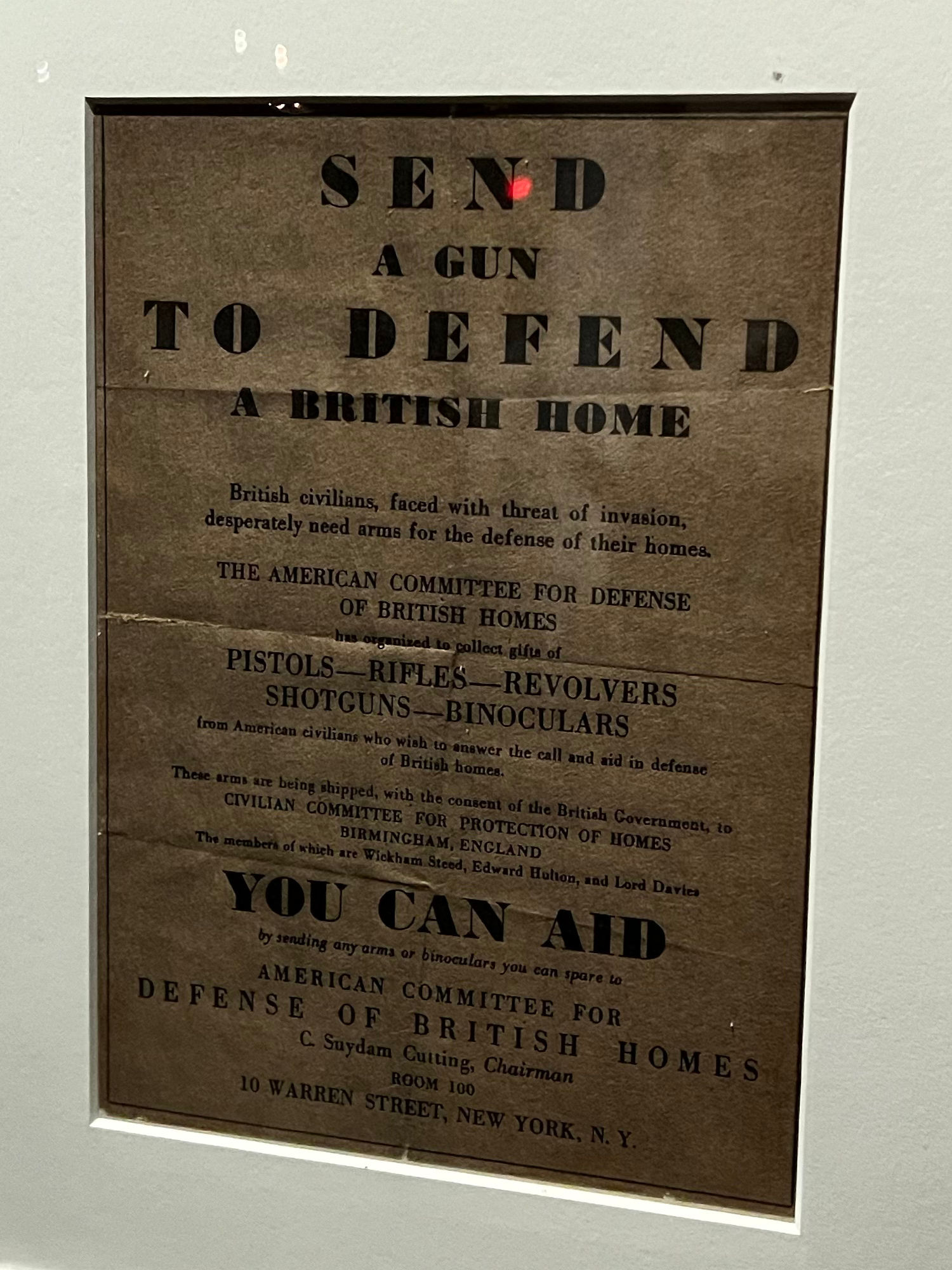
a Gun
to Defend
a British Home
British civilians, faced with threat of invasion, desperately need arms for the defense of their homes.
THE AMERICAN COMMITTEE FOR DEFENSE OF BRITISH HOMES
has organized to collect, gifts of
PISTOLS - RIFLES - REVOLVERS - SHOTGUNS - BINOCULARS
from American civilians who wish to answer the call and aid in defense of British homes.
These arms are being slipped, with the consent of the British Government, to
CIVILIAN COMMITTEE FOR PROTECTION OF HOMES
BIRMINGHAM, ENGLAND
The members of which are Wickham Steed, Edward Holten, and Lord Davies
YOU CAN AID
by sending any arms or binoculars you can spare to
AMERICAN COMMITTEE FOR
DEFENSE OF BRITISH HOMES
C. Suydam Cutting, Chairman
ROOM 100
10 WARREN STREET, NEW YORK, N. Y.
WIKIPEDIALend-Lease
Formally the Lend-Lease Act and introduced as An Act to Promote the Defense of the United States
Was a policy under which the United States supplied the United Kingdom, the Soviet Union, France, Republic of China, and other Allied nations with food, oil, and materiel between 1941 and 1945. The aid was given free of charge on the basis that such help was essential for the defense of the United States.The Lend-Lease Act was signed into law on March 11, 1941, and ended on September 20, 1945. A total of $50.1 billion (equivalent to $719 billion in 2021) worth of supplies was shipped, or 17% of the total war expenditures of the U.S. In all, $31.4 billion went to the United Kingdom, $11.3 billion to the Soviet Union, $3.2 billion to France, $1.6 billion to China, and the remaining $2.6 billion to other Allies. Roosevelt's top foreign policy advisor Harry Hopkins had effective control over Lend-Lease, making sure it was in alignment with Roosevelt's foreign policy goals.
Materiel delivered under the act was supplied at no cost, to be used until returned or destroyed. In practice, most equipment was destroyed, although some hardware (such as ships) was returned after the war. Supplies that arrived after the termination date were sold to the United Kingdom at a large discount for £1.075 billion, using long-term loans from the United States, which were finally repaid in 2006. Similarly, the Soviet Union repaid $722 million in 1971, with the remainder of the debt written off.
Reverse Lend-Lease to the United States totalled $7.8 billion. Of this, $6.8 billion came from the British and the Commonwealth. Canada also aided the United Kingdom and other Allies with the Billion Dollar Gift and Mutual Aid totalling $3.4 billion in supplies and services (equivalent to $61 billion in 2020) .
Lend-Lease effectively ended the United States' pretense of neutrality which had been enshrined in the Neutrality Acts of the 1930s. It was a decisive step away from non-interventionist policy and toward open support for the Allies. Lend-Lease's precise significance to Allied victory in World War II is debated. Stalin told Nikita Khrushchev that Lend-Lease enabled the Soviet Union to defeat Germany.
WIKIPEDIALiberty Ships
A class of cargo ship built in the United States during World War II under the Emergency Shipbuilding Program. Although British in concept, the design was adopted by the United States for its simple, low-cost construction. Mass-produced on an unprecedented scale, the Liberty ship came to symbolize U.S. wartime industrial output.The class was developed to meet British orders for transports to replace ships that had been lost. Eighteen American shipyards built 2,710 Liberty ships between 1941 and 1945 (an average of three ships every two days), easily the largest number of ships ever produced to a single design.
Their production mirrored (albeit on a much larger scale) the manufacture of "Hog Islander" and similar standardized ship types during World War I. The immensity of the effort, the number of ships built, the role of female workers in their construction, and the survival of some far longer than their original five-year design life combine to make them the subject of much continued interest.
The basic EC2-S-C1 cargo design was modified during construction into three major variants with the same basic dimensions and slight variance in tonnage. One variant, with basically the same features but different type numbers, had four rather than five holds served by large hatches and kingpost with large capacity booms. Those four hold ships were designated for transport of tanks and boxed aircraft.
In the detailed Federal Register publication of the post war prices of Maritime Commission types the Liberty variants are noted as:
- EC2-S-AW1
Collier (All given names of coal seams as SS Banner Seam, Beckley Seam and Bon Air Seam)- Z-EC2-S-C2
Tank carrier (four holds, kingposts) – example SS Frederic C. Howe- Z-ET1-S-C3
T1 tanker – example SS Carl R. Gray. Eighteen were commissioned into USN in 1943 as the Armadillo-class tanker- Z-EC2-S-C5
Boxed aircraft transport (four holds, kingposts) – example SS Charles A. Draper. Post war 16 of these Liberty ships were converted 1954–1958 into Guardian-class radar picket shipIn preparation for the Normandy landings and afterward to support the rapid expansion of logistical transport ashore a modification was made to make standard Liberty vessels more suitable for mass transport of vehicles and in records are seen as "MT" for Motor Transport vessels. As MTs four holds were loaded with vehicles while the fifth was modified to house the drivers and assistants.
The modifications into troop transports also were not given special type designations.
WIKIPEDIASS Stephen Hopkins
Was a United States Merchant Marine Liberty ship that served in World War II. She was the only US merchant vessel to sink a German surface combatant during the war.She was built at the Permanente Metals Corporation (Kaiser) shipyards in Richmond, California. Her namesake was Stephen Hopkins, a Founding Father and signer of the Declaration of Independence from Rhode Island. She was operated by Luckenbach Steamship Company under charter with the Maritime Commission and War Shipping Administration.
Action of September 27, 1942
She completed her first cargo run, but never made it home. On September 27, 1942, en route from Cape Town to Surinam, she encountered the heavily armed German commerce raider Stier and her tender Tannenfels. Because of fog, the ships were only 2 miles (3.2 km) apart when they sighted each other.Ordered to stop, Stephen Hopkins refused to surrender, and Stier opened fire. Although greatly outgunned, the crew of Stephen Hopkins fought back, replacing the Armed Guard crew of the ship's lone 4-inch (102 mm) gun with volunteers as they fell. The fight was fierce and short, and by its end both ships were wrecks.
Stephen Hopkins sank at 10:00. Stier, too heavily damaged to continue her voyage, was scuttled by its crew less than two hours later. Most of the crew of Stephen Hopkins died, including Captain Paul Buck. The 15 survivors drifted on a lifeboat for a month before reaching shore in Brazil.
Captain Buck was posthumously awarded the Merchant Marine Distinguished Service Medal for his actions. So was US Merchant Marine Academy cadet Edwin Joseph O'Hara, who single-handedly fired the last shots from the ship's 4-inch gun. Navy reservist Lt. (j.g.) Kenneth Martin Willett, commander of the Armed Guard detachment which manned the ship's 4-inch gun, was posthumously awarded the Navy Cross.
The Liberty ships SS Paul Buck, SS Edwin Joseph O'Hara, and SS Richard Moczkowski, and the destroyer escort USS Kenneth M. Willett were named in honor of crew members of Stephen Hopkins, and SS Stephen Hopkins II in honor of the ship itself.
WIKIPEDIAStier (HSK 6)
was an auxiliary cruiser of Nazi Germany's Kriegsmarine during World War II. Her Kriegsmarine designation was Schiff 23, to the Royal Navy she was Raider J.The name Stier means "bull" and also represents the Taurus constellation in the German language. She was the last German raider to break out into the Atlantic in World War II.
On 27 September 1942 Stier encountered the Liberty ship Stephen Hopkins en route from Cape Town to Paramaribo. Closing in foggy conditions, the two ships sighted each other around 08:52 AM at a distance of 4,000 yards. Gerlach sent his men to action stations; the master of the Stephen Hopkins was suspicious of the unidentified vessel and did the same. The Stephen Hopkins had a small defensive armament (1 × 4 inch gun astern, 2 x 37mm guns of an unknown model forward, and 6 x machine guns), but when firing commenced, around 08:55, she put up a spirited defense. She scored several hits on Stier, damaging her engines and steering gear. However, overwhelmed by fire from Stier, the Hopkins drifted away; by 10 a.m. she had sunk. Forty-two of her crew were killed in the action, and three more died later; the fifteen survivors finally reached Brazil 31 days later. Stephen Hopkins's commander, Captain Paul Buck, was posthumously awarded the Merchant Marine Distinguished Service Medal for his actions. So was United States Merchant Marine Academy cadet Edwin Joseph O'Hara, who single-handedly fired the last shots from the ship's 4-inch gun.
Meanwhile, Stier had been heavily damaged: unable to make headway, and not responding to the helm. Gerlach made the decision to scuttle the ship and prevent her from falling into Allied hands. After the scuttling charges were exploded, Stier sank at 11:40 AM. All but two of her crew survived the fight, and returned to France on the German supply ship Tannenfels, which was accompanying Stier at the time of the action.
WIKIPEDIAMS Tannenfels
Was a German cargo ship owned by DDG Hansa, put into service in 1938. She served as a blockade runner during World War II.When the war broke out in 1939, Tannenfels was at Kismayo, in Italian Somaliland. She remained there until January 1941, when British troops entered Italian Somaliland. She then sailed for Europe via the Cape of Good Hope, eventually reaching German-occupied France.
She was taken over by the Kriegsmarine and commissioned as an auxiliary naval vessel. She was fitted with machine guns and some larger naval guns for self-defense. During the next year and a half, she was employed as a blockade runner, slipping past British patrols to deliver supplies to German armed merchant cruisers at sea. In December 1942 at Bordeaux, she was damaged by limpet mines placed by British commandos (Operation Frankton), and was no longer seaworthy. She was eventually scuttled as a blockship in the Gironde River in 1944.
